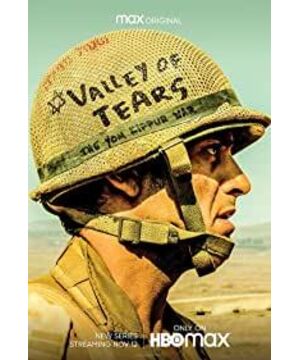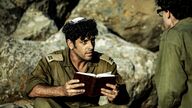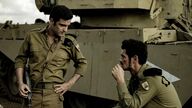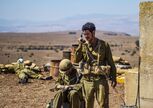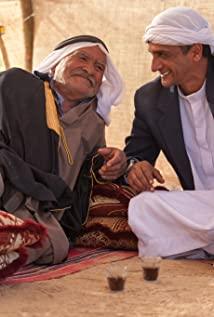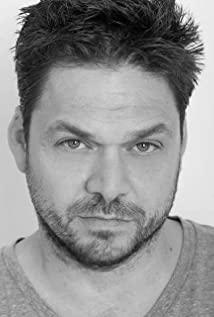Common pseudonym: Führer's Guard
He has lived in Europe for 8 years, is proficient in German, and loves the history of World War II and modern warfare. Since 2000, he has worked on military history websites such as "The Art of War", "German Military Center", and sonicbbs, as well as "Assault" and "War History Research". ” and other print media published many original articles and translated many German movies and TV series with Chinese subtitles
If you are interested in military history and military-themed films, please pay attention to my headline today: Twilight of the Gods Research Association
WeChat public account: Ragnarok Research Society (or search for "WarArtStudy") or scan the QR code of the public account below:
The future will bring more little-known historical details.
Do not reproduce without permission
I recently finished the Israeli TV series "Valley of Tears" (עֵמֶק הַבָּכָא), which premiered on October 19 this year on HBO. The film is rarely set against the backdrop of the Middle East war, through three story lines (tank soldiers, military intelligence officers in frontier fortresses, reporters and Women Soldiers) recreates Israel's ignorance of the crisis due to its victory in the Six-Day War in 1967, the plight of the 1973 Yom Kippur War, and the Jedi's counterattack.
There are a lot of works on the market and the Internet about the process of this battle. This article will not go into details. However, as a military fan, the background of this plot and the weapons appearing in the play are worth studying and researching, and you can also find the corresponding and inconsistency with the real history.
What is "Valley of Tears"
In the third Israeli-Arab War (Six-Day War) in early June 1967, the Israeli Air Force took the lead in attacking and annihilating the Egyptian Air Force, advancing into Egypt's Sinai Peninsula in the south and reaching the Suez Canal, reaching the West Bank of Jordan in the east, and then attacking Syria in the north. The Golan Heights won an overwhelming victory; and finally occupied a vast area including the Sinai Peninsula, the Gaza Strip, the West Bank, and the Golan Heights.
After three years of war of attrition with Arab countries (called לחמת ההתשה in Hebrew, called حرب الاستنزاف in Arabic), none of the Arab neighbors could regain their original territory.
October 6, 1973 was the holiest Day of Atonement (יוֹם כִּיפּוּר, Yom Kippur) in the Jewish year, when prayer was required and no food or work was allowed.
In the afternoon without warning, Egypt crossed the Suez Canal from the south to attack the Sinai Peninsula, and Syria attacked the Golan Heights from the north.
In this campaign, Israel could not resist the double-sided offensive and suffered heavy losses, but on October 8, it repelled the Syrian offensive and returned to the pre-war border. On October 12, it approached Damascus, the capital of Syria. After the Northern Front stabilized, the IDF crossed the Suez Canal to invade Egypt on the evening of October 15, but the offensive was blocked on the west bank of the canal. A ceasefire was finally reached on October 25.
"Valley of Tears" is an idiom in the Jewish and Christian circles, meaning the place of suffering. The first season of the show depicted the Syrian front in the northern Golan Heights during the Yom Kippur War, and the "Valley of Tears" refers to the area where this front fought fiercely in Syria.
The tactical weaknesses of both Israel and Afghanistan
In 1967, Israel won the third Arab-Israeli War (Six-Day War) and plundered a large amount of territory. In the following three years, the Arab-Israeli War of Attrition successfully suppressed the attempts of the Arab neighbors to retake the original territory; therefore, it is convinced to practice the existing tactical concepts. A military victory can be achieved, just like France during the interwar period.
At that time, Israel's victory model was to first gain air superiority by any means, and then use air-to-ground close support to cover the advance of armored forces. Therefore, the principle of building an army is to extremely strengthen aircraft and tanks, while ignoring infantry and artillery.
However, before the outbreak of the fourth Israeli-Arab war (Yom Kippur War) in 1973, Egypt and Syria had made great progress in the technology, quantity and scale of infantry anti-tank weapons and surface-to-air missile defense networks.
The Israeli Military Intelligence Agency (AMAN) did not obtain its combat readiness before the outbreak of the war, so the Arab coalition's choice to launch a raid on Yom Kippur was completely beyond Israel's expectations, resulting in the Israeli Air Force's inability to annihilate ground enemy aircraft with sneak attacks as in the Six-Day War. way to gain air superiority at the start of a war.
Although the Israeli Air Force is still capable of fighting in the air, the surface-to-air missile defense network of the Arab coalition makes it impossible to effectively support the ground at close range, causing tanks to lose eight to ten times the number disadvantage of the Arab coalition. heavy.
At the same time, the Arab coalition infantry used anti-tank weapons to stick to the stronghold, which meant that the Israeli tanks without the coordination of infantry artillery could not attack for a long time and suffered heavy losses.
The film's presentation of the Israeli armored forces' operations is not far from the situation at that time; the Arab coalition has adopted the infantry warfare coordination mode, but its poor command and rigid tactical teaching make the infantry-tank coordination unable to play in actual combat.
In a nutshell, Egypt and Syria have the establishment of the cooperation between the tanks and the tanks, but there is very little cooperation between the tanks and the tanks in actual combat.
In the Yom Kippur War, the offensive mode of the Arab coalition was that the tanks rushed forward, and the mechanized infantry also rushed forward in vehicles; there was no tactical plan for reconnaissance, flanking defense, and detours, just the infantry rushing along with the tanks.
Once the headquarters is destroyed or loses contact, the troops that only know one command and one action will continue to charge forward, recklessly fighting for the numerical superiority with the enemy; they don't even know that they want to leave the road and bypass the damaged vehicles ahead, thus delaying the offensive on their own.
As a result, the attackers with a large numerical advantage continued to ambush and nibble for the small troops of the defenders, gradually disintegrating and retreating.
Real History and the Tanks in the Drama
In the Yom Kippur War, the new 421st Brigade of the Israel Defense Forces, equipped with Magach 3 tanks, has been equipped with APFSDS-Armour-piercing fin-stabilized discarding sabots. The brigade was also the first force to cross the Suez Canal to invade Egypt after the Israeli counteroffensive.
The derivatives and hybrid upgraded versions of the Patton series tanks such as the American M48 and M60 are collectively called Magach tanks (מגח) in Israel, and then given their respective models. Magach means "siege hammer" in Hebrew. .
Before the outbreak of the Yom Kippur War, the existing Magach 1 (M48A1) and Magach 2 (M48A2C) of the Israel Defense Forces had been replaced with engines and upgraded to A3 specifications, and replaced with US-made 105 mm M68 without muzzle brakes Rifled gun (ie licensed British L7 rifled gun). This hybrid upgraded M48A3 is called the Magach 3.
During the Yom Kippur War, more than 500 Israeli Magach tanks were all deployed on the Egyptian front line in the southern Sinai Peninsula, while the number of Soviet-made T-62 main tanks with APFSDS ammunition was still small.
At that time, the armor-piercing shells (APDS), high-explosive anti-tank shells (HEAT) and armor-piercing shells (HESH) commonly used by Israeli tanks were sufficient to deal with the mainstream T-54/55 tanks of the Arab League.
The plot of this film is the Syrian front in the northern Golan Heights. This front does not deploy the Magach tanks of the American-made Patton series, but another Short tank.
Before the outbreak of the Yom Kippur War, the IDF's thousands of British "Centurion" tanks of various types had been replaced with American-made 105 mm M68 rifled guns (that is, authorized production of British L7 rifled guns), collectively referred to as SCHOTT tanks. Short (שוט) means "whip" in Hebrew.
This M68 rifled gun is also equipped with the Magach 3 tank (M48A3 hybrid upgrade), which can launch APFSDS shells. But at that time APFSDS was only an experimental bullet, and it was not officially mass-produced until the late 1970s.
The eighth episode of this film mentions three types of anti-tank rounds for the Short tank:
Armour-piercing discarding sabot (APDS),
high-explosive anti-tank (HEAT),
High-explosive squash head (HESH);
This was the main ammunition used by the IDF tanks with 105 mm main guns at that time. In the film, the tank crew members in the battle often mentioned loading HESH or APDS, but HEAT did not mention it.
The picture below shows the ammunition used by most Israeli tanks equipped with the American 105 mm M68 rifled gun during the Yom Kippur War, from left to right:
Shell-piercing projectiles (APDS)
Tail Stabilized Shell Piercing Projectile (APFSDS)
High Explosive Anti-Tank (HEAT)
Anti-personnel bombs (APERS)
Armor Shatter (HESH).
In episode 9's short tank ammunition supply scene, it can be determined from the shape that there are three HEATs next to the ammunition box, and two APFSDS in the ammunition box. But APFSDS was not widely distributed at that time, it should be APDS only reasonable.
The film is entirely in Hebrew.
Kinetic armor-piercing rounds such as APDS are חודר שריון in Hebrew. Shaped charge (or hollow charge, HEAT) in Hebrew is מטען חלול, free translation of hollow charge, pronounced ha'lun.
Squash head (HESH) in Hebrew is פגז נפיץ פלסטי, or מעיך for short, pronounced meiich. The eighth episode introduces the use of ammunition by the Short Tank in the order חודר שריון (APDS), חלול (HEAT), and מעיך (HESH).
In the whole episode, most of the tank commander's instructions are to reload APDS and occasionally HESH, and HEAT probably only appears when the eighth episode introduces tank ammunition. APFSDS (historically should not exist at this time) and HEAT can be seen inside the Schott tank in the album, but HESH is not seen.
But whatever the order, the loader is loading APFSDS. The English subtitles translate all the instructions into HESH; the Chinese subtitles refer to APDS for armor-piercing bullets and HESH for hollow-charge grenades. Obviously, the difference in the instructions for loading ammunition has been noticed, but HESH is mistaken for HEAT.
For example, in the first tank battle, the commander instructed to reload kinetic armor-piercing rounds חודר שריון (APDS), but the English subtitles were HESH.
The SCHOTT tank does have HEAT inside, and the loader is instructed to load the kinetic energy armor-piercing projectile APFSDS, which was only popularized 5 years later.
The following scene instructions should be loading armor shredding shells מעיך (HESH), the Chinese subtitles are HEAT, and the loader loads APFSDS like the loader.
By the way, this war is also the last battle for Israel to refit the American M4 Sherman tank . The AMX-13 light tank, mass-produced in 1952, was the first extremely successful French tank after the war. The AMX-13 is armed with a French 75 mm SA 50 (or CN 75-50) tank gun.
This gun is not, as rumored, a direct imitation of the 7,5 cm KwK 42 L/70 tank gun of the German Panther tank of World War II, but its design is indeed based on the KwK 42.
The SA 50 shortens the caliber to L/61, and the shell size of 75 x 597R is also shorter than the 75 x 640R shell size of the KwK 42. However, its propellant has been improved to achieve a muzzle velocity of 1000 m/s similar to that of the KwK 42.
Israel's self-modified Sherman M-50 is the CN 75-50 tank gun equipped with AMX-13 (called M-50 after Israel purchased it), which was launched in 1956.
The second-generation modified Sherman M-51 was equipped with a French 105 mm CN 105-57 tank gun (called M-51 after Israel purchased it), and was introduced in 1965. The CN 105-57 tank gun is equipped with a stabilized shell-piercing shell with a tail, and the muzzle velocity can reach 1430 m/s.
These two modified US-made M4 Sherman tanks are commonly known as "Super Sherman" (Super Sherman), and the M-51 is also known as Isherman (Israel Man). But they are not official titles.
The M-50 and M-51 tanks were the main armored armour of the Israel Defense Forces in the third Israeli-Arab War (Six-Day War) in early June 1967. When Israel acquired the British "Centurion" and the American M48 and M60 "Patton" tanks since the 1960s, the Sherman tanks have been phased out and replaced.
In the Yom Kippur War in early October 1973, due to unpreparedness, only about 340 of these two modified Sherman tanks had to be put into the battlefield. The explosive anti-tank bomb (HEAT) can also compete with the T-54, T-55, and T-62 of the Arab coalition.
Compared with the appearance features of the M-50 tank, the M-51 tank has a large muzzle brake, three spare tracks in front of two smoke grenade launchers on the side of the turret for lateral suspension; two storage boxes on the body are located at the rear are shorter. This is one of two standard configurations of the M-51 tank, without exception.
Another standard configuration of the M-51 tank is the same as that of the M-50 tank: three spare tracks are suspended on the front side of the body, and there is only one storage box. Different configurations may come from different production plants, and actual force use coexists.
Cross-connected reactive armor
The front edge of the turret of the Short tank in this film has strips and bolts. This device is used to mount Blazer's explosive reactive armour (ERA). But this detail is a fiction that does not exist in real history.
The reactive armor lifts off the upper armor plate in an explosive manner, and then detonates in advance and changes the penetration angle to destroy the metal jet or kinetic energy armor-piercing core, reducing its armor-piercing ability. This was inspired by the actual combat experience of the Yom Kippur War, but there was no such device in the Yom Kippur War.
Located in the Israeli settlement area of Meren Golan in the Golan Heights, there is a memorial area for the Yom Kippur War on Hermonic Hill overlooking the fierce battle area of the "Valley of Tears".
The Short tank displayed in this park was also modified after the Yom Kippur War and can be mounted with reactive armor. Therefore, it is a scene specially placed with retired tanks, rather than abandoned vehicles damaged in battle.
The installation of the Blazer reactive armor plate is very simple, as long as the bolts are welded at the designated positions of the car body and turret and then hung.
Israel's main station tanks Short (Centurion), Magach 5 (M48A5), and Magach 6 (M60A1) in the first half of the 1980s were all installed. Full equipment weight increased by one ton.
US military aid
During the Yom Kippur War, the IDF lost or lost about 300 Magach tanks.
On October 13, 1973, the United States launched military aid (including sea and air operations codenamed Nickel Grass) in the middle of the war to deliver 200 old M48A3 and M60/A1 tanks to Israel, but most of them were after the war. Just arrived.
In this batch of US aid tanks, only the M60/A1 equipped with the 105 mm M68 rifled gun was immediately dispatched to the 14th, 401st, and 600th brigades of the Israel Defense Forces; and the M48A3 equipped with the 90 mm M41 rifled gun must be replaced by the 105 mm M68 in the factory first to achieve the desired performance. There are specifications for the Magach 3 tank. The US did not introduce the M48A5 with the 105 mm M68 until 1975.
The code name for this military aid operation, Nickel Grass, means "Blessing Gold" and "Redemption Gold", which is derived from the self-arranged song "...throwing a nickel on the grass, save a fighter pilot's" sung by US fighter pilots during the Korean War in the 1950s ass...throw a nickel on the grass and you'll be saved".
This song is inspired by the "Throw a nickel on the drum and you'll be saved" when the Christian charity organization "The Salvage Army" played on the streets to raise money in the early 20th century and used the drum to catch passersby donating change. slogan.
Israel Defense Forces Small Caliber Firearms
During the Yom Kippur War in early October 1973, 9 mm Uzi submachine guns were generally equipped with infantry and paratrooper unit sergeants (squad leader and above), reserve infantry units, tank crews, artillery units, and special forces. Its small size and high rate of fire are highly consistent with the needs of the Israeli Defense Forces, which emphasized tanks and mechanized infantry. However, the effective range is short and the accuracy of automatic shooting is poor.
Infantry and paratrooper units are primarily armed with 7.62 mm FN FAL battle rifles. The Israeli-made FAL is one of the metric versions, and the handguard and stock have a unique look and are easily recognizable.
Although the effective range is long, the Israeli army thinks it is too heavy and too long to be suitable for the mechanized infantry combat they are good at, and the FAL bolt is easy to get stuck in the desert. Although it has been improved, the sand discharge groove is cut out. However, the effect was unsatisfactory. Before the Yom Kippur War, the Israeli army had planned to eliminate it. After the war, the 5.56 mm Galil assault rifle was gradually replaced.
The platoon-level machine gun for infantry and paratroopers is the 7.62 mm FN MAG light machine gun.
Before the Yom Kippur War, the 5.56 mm Galil assault rifle had been equipped with a small number of troops.
Of these small caliber guns, the 7.62 mm FN MAG LMG is the most durable. The firearms abandoned by the Israel Defense Forces in the Sinai Peninsula at the beginning of the Yom Kippur War, after the counter-offensive recapture, only the FN MAG can still be used normally.
View more about Valley of Tears reviews


